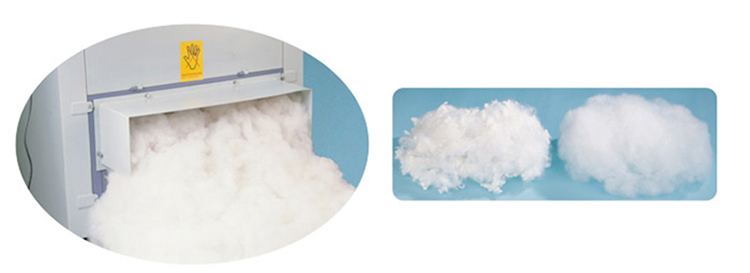How To Improve Fiber Opening Effect?

Key factors affecting fiber opening effect
Feeding method and feeding amount: The amount of fiber fed into the opener should be uniform and appropriate. Otherwise, too much raw material will be fed at one time, and the fiber will enter the fan before being torn by the licker-in roller, which will easily form a large fiber mass. The feeding amount should be controlled to evenly spread the raw material on the feeding curtain or roller to avoid "full feeding" or high and low feeding methods.
Feed roller and licker-in needle tooth spacing: Reasonably adjust the spacing between the feed roller and the licker-in needle teeth according to the fiber length. The longer the fiber, the larger the spacing can be used; the shorter the fiber, the smaller the spacing should be.
Tick-in roller speed: The high-speed rotation of the licker-in roller can increase the number of openings per unit length of fiber, increase the opening force, and open more fully, but too high a speed will cause the fiber to be over-torn.
Tick-in roller needle tooth state: The licker-in roller needle teeth should be kept sharp and flat to effectively open the fiber. Passivated or damaged needle teeth will cause the fiber hook to slip, affecting the opening effect. The needle teeth should be checked and replaced or the knife roller should be polished regularly to ensure the opening force.
Fiber raw material characteristics: Different raw materials (cotton, chemical fiber, wool, regenerated fiber, etc.) have different fiber length, maturity, and compactness. The shorter, more brittle, or more impurities in the fiber, the more difficult it is to open, and special attention should be paid to parameter matching. Before use, the raw materials should be pretreated as much as possible (such as tearing up old cloth, cleaning impurities, dismantling fiber packages, etc.) to reduce the burden of opening.
Fiber moisture content and static control: When the moisture content of the raw material is too low, the fiber is easy to produce static adhesion when it is dry, making the fiber easy to clump; if the moisture content is too high, the fiber is easy to clump. The fiber moisture content should be kept within an appropriate range, and attention should be paid to the humidity control in the workshop.
Practical suggestions for optimizing the opening effect
Uniform feeding and appropriate feeding: Keep the feeding equipment (such as screw feeder, vibrating plate, conveyor belt, etc.) running stably, and spread the raw materials evenly on the feeding roller. Feeding too much or too fast will cause cotton balls or lack of materials; feeding too slowly or too little will affect the output. It is recommended to make a trial adjustment for new raw materials first to find the appropriate feeding amount and speed.
Adjust equipment parameters: Adjust the needle clothing spacing, licker-in roller speed and fan air volume according to the raw material conditions. When cotton balls appear, the speed and air volume can be appropriately adjusted; when the fibers are too broken, the spacing can be increased or the impact intensity can be reduced, and the opening can be carried out in sections (first low-speed rough opening and then high-speed fine opening). Regularly monitor and fine-tune during production to avoid the equipment running under wrong parameters for a long time.
Clean impurities and maintain equipment: Before opening, metal, hard particles and other impurities in the raw materials should be cleaned to prevent damage to the machine and blockage. Clean the fiber accumulation on the licker-in roller and barrel regularly to keep the dust collection system unobstructed. At the same time, ensure that the equipment bearings, reducers, etc. operate well, add oil and lubricate when necessary to prevent abnormal vibration from affecting feeding stability.
Anti-static and anti-flying measures: In dry weather or when the chemical fiber content is high, the fibers are prone to static electricity. You can install an electrostatic eliminator (ion fan, ion rod) in the opening system or increase the relative humidity of the workshop (such as using an atomizing humidifier). In addition, appropriately lowering the ambient temperature or adding an anti-flying cover can reduce static flying and ensure a smooth opening process.
Pay attention to cotton balls and short fibers: cotton balls and too many short fibers should be dealt with quickly. When it is found that the fibers are sticking together, the machine should be stopped for inspection, the lumps should be removed and the causes should be found out (such as excessive feeding, damaged needle clothing, etc.). When the fibers are too short, the speed of the licker-in roller can be slowed down or the needle clothing with a larger spacing can be replaced to reduce the fiber short breakage rate. Through these operating points, common opening defects can be effectively avoided and the opening quality can be continuously optimized.
About INNOLD's Fiber Opener
Raw materials are widely applicable: Our company's fiber opener is suitable for various raw materials, such as cotton, polyester fiber, wool, textile waste and other filling materials, especially to meet the needs of opening and breaking up home textile filling cotton and toy filling cotton. According to different fiber lengths and characteristics, we provide a variety of needle roller specifications and adjustment mechanisms to ensure that the equipment can smoothly handle materials with large differences in looseness.
Efficient and uniform output: The opening efficiency is high, and the output can reach hundreds of kilograms per hour (depending on the machine model and raw materials); the fibers after opening are fluffy and uniform, the length is stable, and there are no obvious cotton balls and short fibers. Our machine has good cotton output uniformity, which can be seamlessly matched with downstream automatic cotton dispensing or filling machines, significantly improving production efficiency and finished product quality.
Structural highlights design: The equipment adopts a fully enclosed steel frame structure, the whole machine is compact and durable and has a safety shield; the distance between the feeding roller and the licker-in roller, the type of licker-in roller needle clothing, and the fan air volume can be adjusted, and the operation is flexible. Optional static elimination and dust removal devices can help further stabilize the opening effect. Our openers have a reasonable structure, low vibration, low noise, simple and safe operation, and convenient daily maintenance.
Durable and easy to maintain: key components are made of high-quality alloy steel and bearings, and the knife rollers are wear-resistant and have a long service life. When disassembling and repairing, you only need to loosen the bolts to quickly replace the card clothing or clean the fiber. The whole machine adopts a modular design for easy maintenance. We can also customize the equipment layout according to the customer's workshop space and production line requirements to ensure convenient installation and worry-free maintenance.
In short, by reasonably controlling the key factors of the opening process and combining efficient fiber openers, the opening effect and production efficiency can be effectively improved. Our company has many years of experience in the research and development and manufacturing of openers, and can provide professional fiber opening equipment and technical support for customers in industries such as home textile factories, toy factories, and recycled cotton factories, helping your production line to achieve a stable and uniform filling cotton breaking effect. Welcome to contact us for more equipment information and customized services.
Post time:2025-07-04
